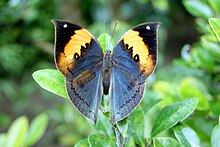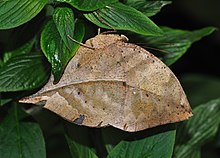Kallima inachus
| Orange oakleaf | |
|---|---|
 |
|
| Upperside | |
 |
|
| Underside | |
|
Not rare
|
|
| Scientific classification | |
| Kingdom: | Animalia |
| Phylum: | Arthropoda |
| Class: | Insecta |
| Order: | Lepidoptera |
| Family: | Nymphalidae |
| Genus: | Kallima |
| Species: | K. inachus |
| Binomial name | |
|
Kallima inachus (Doyère, 1840) |
|
Kallima inachus, the orange oakleaf, Indian oakleaf or dead leaf, is a nymphalid butterfly found in tropical Asia from India to Japan. With wings closed, it closely resembles a dry leaf with dark veins and is a spectacular and commonly cited example of camouflage.
The butterfly wings are shaped like a leaf when in the closed position. When the wings are closed, only the cryptic underside markings are visible, which consists of irregular patterns and striations in many shades of biscuit, buff, browns, yellow, and black. The veins are darkened and resemble the veins of a leaf. The resemblance to a dried leaf is extremely realistic and gives the genus its common names, the oakleaf or dead leaf.
When the wings are open, the forewing exhibits a black apex, an orange discal band and a deep blue base. There are two white oculi, one along the margin of the apical black band, and the other bordering the orange and deep blue areas. The hindwing is more uniformly blue but diffused with brown patches along the termen.
Male and female butterflies are similar except that the female is generally larger and has the apex of the forewing protrude to form a longer point. Females also tend to be more reddish on the underside and the yellow mottled markings tend to be paler. The butterfly exhibits polyphenism, i.e. there are specific dry-season and wet-season forms which differ in colouration and size; the wet-season form tends to be smaller.
The wingspan of the butterfly ranges from 85 to 110 millimetres (3.3 to 4.3 in).
Detailed description as given in Bingham (1905).
The forewing discoidal cell, interspace 1a, 1 to near apex, basal half of 2, and extreme bases of 3 and 4 rich violet blue, the borders of the discocellulars and the interspaces of veins 2, 3 and 4 are black, spread diffusely outwards in interspaces 1a and 1. A very broad oblique discal orange band from costa to apices of interspaces 1 and 2, this orange band is sprinkled with bluish black scales; apical third of wing velvety purpurescent (purple) black; a hyaline (glass-like) transverse spot near middle of interspace 2, and a subtriangular similar small preapical spot. Hindwing more uniform violescent blue; the costal margin and apex very broadly brown, somewhat densely irrorated (sprinkled) with dusky violescent black scales; dorsal margin brown; a ridge of long brownish hairs along vein 1 spreading on to the dorsal margin. Forewings and hindwings crossed by a subterminal dusky zigzag line commencing about the middle of interspace 3 in the forewing, and most conspicuous on the hindwing.
...
Wikipedia
